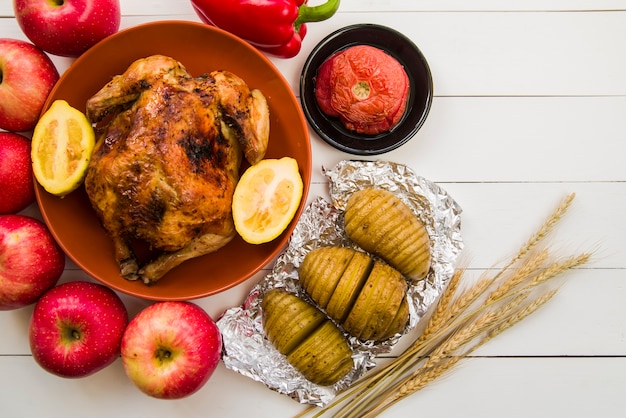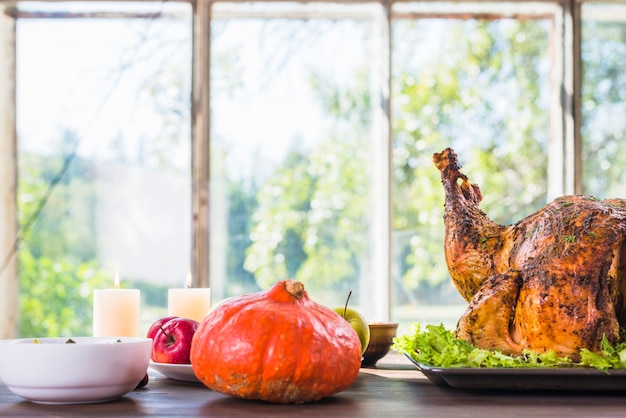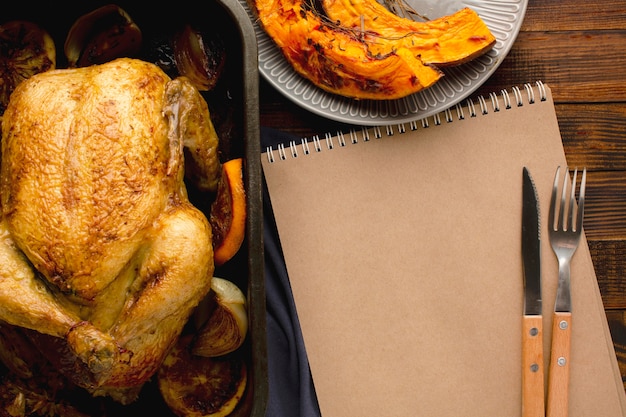Christmas is just around the corner, and you've got a whopping 22lb turkey to tackle. The thought of roasting such a behemoth can be a bit daunting, right? "How long do I roast this thing?" you might be asking. Don't worry, I've been in your shoes. Last year, I was a bundle of nerves, trying to figure out if I was going to end up with a dry, overcooked turkey or a raw one. But then, I discovered a foolproof method, and let me tell you, it was a total game-changer. That turkey was so juicy and flavorful, it was the star of the Christmas feast. This year, I'm spilling all my secrets, so you can confidently conquer that 22lb turkey and impress everyone with your culinary skills.
(Part 1) The Basics: Understanding turkey roasting

First things first, let's get the basics down. roasting a turkey isn't rocket science, but there are a few key things to remember. It's a journey, taking the bird from raw to a succulent, golden-brown masterpiece.
1. roasting time: A Rough Guide
A 22lb turkey needs a good long roasting time – we're talking about 3-4 hours, at least! The exact time depends on your oven and how hot you set it. I personally prefer a temperature between 325°F (160°C) and 350°F (175°C). For a 22lb bird, I usually aim for 325°F, as it helps cook the turkey evenly without drying it out. You want that delicious, moist texture, right?
2. The Importance of Temperature
This is crucial. You need to ensure the turkey is cooked through, but you don't want to overcook it. The sweet spot is an internal temperature of 165°F (74°C) in the thickest part of the thigh. This is where a meat thermometer becomes your best friend! Don't rely on the little pop-up thermometers that come with turkeys – those are notorious for being inaccurate. Get yourself a good digital thermometer; they're worth their weight in gold.
3. The Turkey's Journey: From Raw to Ready
The first hour of roasting is key. The turkey needs to reach a good internal temperature before it starts to cook properly. This is why I always recommend stuffing the turkey after the first hour. It ensures the stuffing cooks thoroughly without drying out the turkey. And before you even think about roasting, pat the turkey dry. This will help the skin crisp up beautifully, giving you that delicious golden-brown color everyone loves.
(Part 2) My Secret Weapon: The Brine

Okay, now we're getting into the good stuff. This is where my magic happens. I'm talking about brining. Think of it as a culinary secret society – it's a simple technique that transforms a turkey from ordinary to extraordinary. It involves soaking the turkey in a salt-water solution for a few hours, or even overnight. The salt draws out moisture from the turkey, which it then re-absorbs, making it super juicy and flavorful. It’s like a little hydration spa for your turkey.
1. Brine Recipe: A Symphony of Flavors
I love a simple brine recipe. I combine water, salt, sugar, and a few aromatics like bay leaves, peppercorns, and garlic cloves. It's all about creating a delicious base flavor that complements the turkey. I often add a bit of lemon or orange zest for a touch of citrusy brightness. It's a little ritual for me, the scent of the brine always gets me excited for Christmas dinner!
2. Brining Tips: From Prep to Patience
Before you start brining, make sure you have a container large enough for your turkey to be fully submerged. A large stockpot or a cooler works perfectly. When you're ready, rinse the turkey and pat it dry. Then, submerge it in the brine for at least 4 hours, but up to 24 hours. After that, remove it from the brine, pat it dry, and get ready to roast!
(Part 3) Roasting Time: Let's Get Specific

Alright, so you've got your turkey prepped and ready to go. Now, let's talk about that roasting time. Remember that 22lb bird? Here's a more specific breakdown, based on my years of experience and countless turkey roasts:
For a 22lb turkey:
| Oven Temperature | Estimated Roasting Time |
|---|---|
| 325°F (160°C) | 3.5 - 4 hours |
| 350°F (175°C) | 3 - 3.5 hours |
Note: These are just estimates. Your turkey might need a bit more or less time depending on its shape and your oven. The key is to keep a close eye on it and use that meat thermometer to check for doneness.
(Part 4) roasting techniques: A Master Class
Now, let's talk about the actual roasting process. There are a few techniques you can use to make sure your turkey is cooked to perfection and achieve that irresistible golden-brown color.
1. Roasting with a Roasting Rack
This is a classic method, and it's my personal favorite. A roasting rack elevates the turkey, allowing air to circulate all around it. This helps the turkey cook evenly and allows the skin to crisp up beautifully. You can use a wire roasting rack or even create a bed of onions or carrots to achieve the same effect. Think of it as a little air-conditioned nest for your turkey!
2. The Breast-Down Method: A New Approach
This method involves roasting the turkey breast-down for the first part of the cooking time. It’s supposed to help keep the breast moist and prevent it from drying out. It's a bit of a gamble, but some people swear by it. I tried it once and it seemed to work, but I prefer the traditional method, just because I’m a creature of habit!
3. Basting: The Art of Moisture
Basting is where you get to be creative! You can use a basting mixture to keep the turkey moist during the cooking process. A classic basting mixture is butter, herbs, and lemon juice. You can also use pan drippings for basting, but be careful not to get any of the fat from the drippings on the turkey’s skin – that’ll prevent it from browning nicely.
(Part 5) The Golden Hour: The Final Stages
So, your turkey has been roasting for a couple of hours, and you're starting to smell that delicious aroma. Now, it’s time for the final stage, the moment of truth! The turkey is almost done, and it’s all about getting that perfect golden-brown skin.
1. Checking for Doneness: The Thermometer Test
This is crucial. The internal temperature should be at least 165°F (74°C) in the thickest part of the thigh. You should also be able to pierce the turkey with a fork, and the juices should run clear. If you're still unsure, stick a thermometer into the thickest part of the breast – it should register at least 165°F (74°C).
2. The Resting Period: A Moment of Patience
Once the turkey is cooked, you need to let it rest for at least 30 minutes before carving. This allows the juices to redistribute, making the turkey more succulent and juicy. Cover the turkey loosely with foil while it rests. It's a bit of a test of patience, but trust me, it's worth it.
(Part 6) Carving Time: A Culinary Triumph
You've done it! Your turkey is cooked, rested, and ready to be carved. This is the moment you've been waiting for, and it’s all about making it a beautiful and memorable experience.
1. The Art of Carving: Tips and Techniques
Use a sharp carving knife to carve the turkey. You can use a carving fork to hold the turkey steady as you carve. Start by cutting off the wings and the legs. Then, carve the breast into slices, making sure to go against the grain. You can also carve the turkey into smaller pieces if you prefer.
2. The Feast: A Celebration of Flavor
It's finally time to enjoy the fruits of your labor! Serve your beautifully roasted turkey with all your favorite sides – stuffing, gravy, mashed potatoes, cranberry sauce – and get ready to feast! This is the moment to savor the flavors, the company, and the joy of Christmas. You’ll be the envy of every Christmas gathering, with your perfectly cooked turkey and your confident air as you serve it up.
(Part 7) The Aftermath: Leftovers and Storage
Okay, so you've had your Christmas dinner, and there's a mountain of turkey leftovers. What do you do with them? Don’t worry, I’ve got you covered!
1. Leftover Magic: Transforming Turkey Into Delicious Delights
Leftover turkey is a blank canvas for culinary creativity. You can use it for sandwiches, salads, soups, or even a delicious turkey pot pie. Get creative and experiment with different flavors! It's the best part of Christmas dinner, in my opinion! The possibilities are endless.
2. Storage Solutions: Keeping Your Turkey Fresh
Store your leftover turkey in the refrigerator for up to 4 days. If you want to keep it for longer, you can freeze it. I like to separate the turkey meat into portions and freeze it in freezer-safe bags. It's always handy to have a stash of turkey in the freezer for those quick and easy meals.
(Part 8) FAQs: Your Questions Answered
You've got questions, I've got answers. Here are some common questions about turkey cooking:
1. What Happens if My Turkey Isn't Fully Cooked?
If the turkey isn't fully cooked, you need to return it to the oven to cook it through. It's a good idea to check the internal temperature every 30 minutes or so until it reaches 165°F (74°C). Don't worry if it's slightly overcooked, it's better to be safe than sorry.
2. Can I Cook a stuffed turkey?
I wouldn’t recommend stuffing the turkey before roasting. It's generally best to cook the stuffing separately, as this ensures it's cooked through thoroughly. You can also stuff the turkey after the first hour of roasting, but be careful not to overfill it.
3. How Do I Make My turkey skin crispy?
The key to crispy turkey skin is to dry it thoroughly before roasting. You can also brush the skin with melted butter or oil. For extra crispiness, you can roast the turkey uncovered for the last 30 minutes of cooking. But be careful, don’t let the skin burn.
4. What Happens if My Turkey Is Overcooked?
Overcooked turkey can be dry and tough. If your turkey is overcooked, there's not much you can do to salvage it. However, you can make it a bit more moist by adding some gravy or sauce.
5. How Long Should I Brine My Turkey?
I like to brine my turkey for at least 4 hours, but you can brine it for up to 24 hours. The longer you brine it, the more flavorful and juicy it will be. However, if you’re pressed for time, you can get away with brining for a shorter period.
There you have it, my guide to cooking a 22lb turkey! Remember, it's not about being perfect, it's about enjoying the process and creating delicious memories. So, go forth, brave cooks, and conquer those Christmas turkeys! You've got this!
Everyone is watching

Prime Rib Roast Cooking Time Chart: Per Pound Guide
Cooking TipsPrime rib roast. Just the name conjures images of lavish dinners, crackling fires, and hearty laughter. It’s ...

How Long to Bake Potatoes in the Oven (Perfect Every Time)
Cooking TipsBaked potatoes are a staple in my kitchen. They're incredibly versatile, delicious, and surprisingly easy to m...

Perfect Rice Every Time: The Ultimate Guide to Cooking Rice
Cooking TipsAs a self-proclaimed foodie, I've always been a bit obsessed with rice. It's the foundation of countless cuisi...

The Ultimate Guide to Cooking Asparagus: Tips, Techniques, and Recipes
Cooking TipsAsparagus. The mere mention of this spring delicacy conjures up images of vibrant green spears, crisp and burs...

Ultimate Guide to Cooking the Perfect Thanksgiving Turkey
Cooking TipsThanksgiving. Just the word conjures up images of overflowing tables laden with delicious food, the scent of r...
